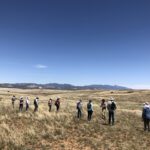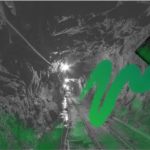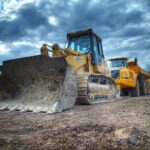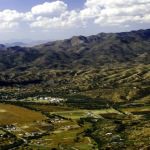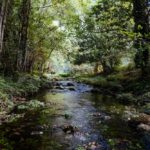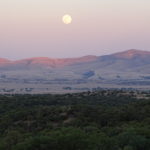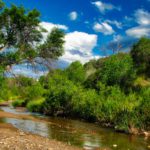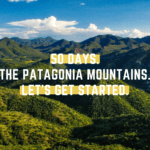
Mar 12, 2013 | Blog
The Patagonia Area Resource Alliance is working to stop industrial mining in the Patagonia Mountains. We are very concerned about protecting and preserving the town’s water supply. Part of our mission also includes promoting the local tourism-based economy to our surrounding public lands and parks. The interesting thing that I’ve discovered while working for PARA is that our mission overlaps or complements the mission of many other organizations both local and national. Given that we’re on the Mexican border, I can say international organizations too! One of those organizations that complements our work is Wildlands Network.
John Davis with Wildlands Network is hiking the Western Wildway of the continent from Mexico to Alaska to promote awareness of the need for wildlife corridors. The Western Wildway is a 6,000-mile-long wildlife corridor that includes Mexico, the United States and Canada. According to their website, “protecting the Western Wildway represents North America’s best chance to ensure the survival of many threatened keystone species that require long-distance movement pathways, including grizzly bear, lynx, mountain lion, wolves, jaguars, and ocelots — all faced with growing pressure from development-based habitat fragmentation and climate disruption.” Learn more at www.trekwest.org
John Davis recently traveled through Patagonia, Arizona. PARA got the opportunity to show him the area in the Patagonia Mountains that is being threatened by Wildcat Silver’s proposed open pit mine. Accompanied by Matt Clark from the Southwest office of Defenders of Wildlife and Sergio Avila from Sky Island Alliance, we climbed American Peak in the Patagonia Mountains. We discussed how the wildlife corridor for jaguars, ocelots, bears and mountain lions through the Patagonia Mountains would essentially be blocked by the proposed Wildcat Silver mine. At the top of the peak, we could see into Mexico. The Patagonia Mountains are only one of two sky island mountain ranges that cross the border into Mexico. Sergio Avila quoted a study that showed that our bear population in the Patagonias is more closely related to bears in Mexico than they are in the nearby Santa Rita Mountains. The bird’s-eye view from the top further demonstrated the importance of the Patagonia Mountains as a wildlife corridor and the vast area of the mountains that would be impacted by Wildcat Silver’s proposed open pit mine, tailings piles, waste rock, tailings ponds and processing plants. Open pit mining operations and wildlife corridors cannot coexist.

Sergio Avila with John Davis on American Peak.
Photo ©Glen E Goodwin
We were thankful for the opportunity to bring our mission to stop mining in the Patagonia Mountains to the attention of an international organization with a complementary mission to keep North American wildlife corridors open. There are so many good reasons to keep open pit mining out of the Patagonia Mountains. Keeping vital wildlife corridors open is another one.
Wendy Russell

Mar 4, 2013 | Blog
The Super Citizen Advocacy Workshop hosted by the Patagonia Area Resource Alliance and Sky Island Alliance was a great success! We had over 30 folks come spend a beautiful Saturday afternoon with us in Cady Hall
The afternoon started out with Wendy Russell discussing the 5 mining projects with applications for mining exploration in the Patagonia Mountains. Three of the projects are situated at the head of the watershed for the town of Patagonia. Read more here: http://www.patagoniaalliance.org/patagonia-mining-proposals/

Melanie Emerson, Executive Director of Sky Island Alliance
Next up was Melanie Emerson, Executive Director with Sky Island Alliance with an exercise for the attendees of “Why are YOU here.” Answers ranged from protecting the mountains, saving the watershed, preserving dark skies, preserving peace and quiet to finding out how to help PARA stop the mines.
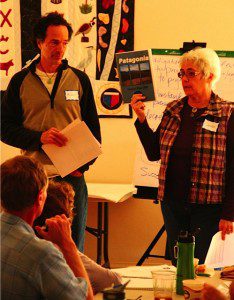
PARA Board Members Michael Stabile and Carolyn Shafer
Michael Stabile and Carolyn Shafer gave a presentation on current Patagonia directives that may be related to mining. Michael cited the new Vehicle Weight Ordinance and Watershed Policy which both help to protect the town from the extreme traffic and water usage that comes with mining. Carolyn Shafer discussed the Town Plan. The plan is very explicit when it comes to mining activity. It states as one of its goals, “Discourage mining and other activities that damage or detract from Patagonia’s environmental and scenic quality.” Read the Town Plan here.
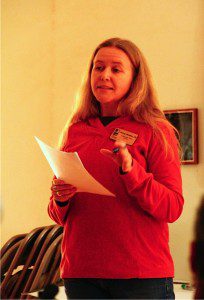
Jenny Neeley with SIA
Jenny Neeley Conservation Policy Director and Legal Counsel for Sky Island Alliance gave an overview of State and Federal Laws that affect mining on public lands. Some more familiar federal laws are the 1872 Mining Law, Clean Water Act and the Clean Air Act.
For an overview of the National Environmental Policy Act, we were very fortunate to have an expert, Dinah Bear. She had the unenviable task of condensing her 5 day course into a 30 minute discussion on NEPA. We’re all grateful for the copies of The Citizen’s Guide to NEPA that she brought. She also reminded us that you don’t have to be an expert to comment on these mining proposals.
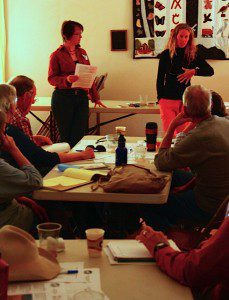
Wendy Russell & Kathi Noaker with PARA
Kathi Noaker and Wendy Russell helped to wrap up the afternoon with all of the different ways participants can spread the message about the threats to the town of Patagonia’s water, natural resources and community. We ended with many of the participants coming forward to sign on to help the PARA mission of education and outreach regarding the potential threats from mining in the Patagonia Mountains. Our super citizens of the town of Patagonia were amazing!
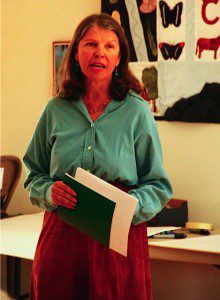
NEPA expert Dinah Bear
Thank you everyone! Special thanks to Dinah Bear, Jenny Neeley, Melanie Emerson and Patagonia® for helping to make it all possible!
Photos by Glen E Goodwin ©2013
For another view on the workshop, read “Save the Scenic Patagonia Mountains” blog by owner of the local B&B, A Room with a View. Thanks Sonia! Blog link: http://bit.ly/VKhUqu
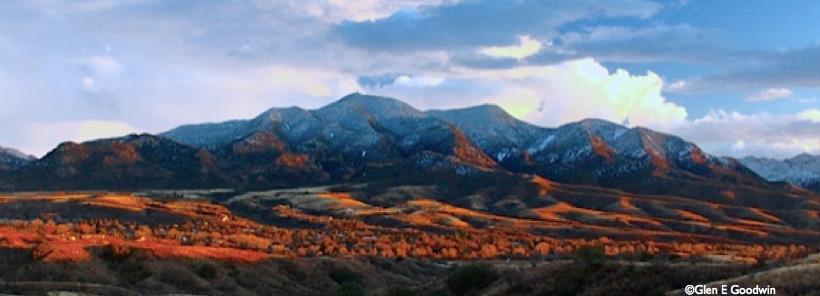
Feb 9, 2013 | Blog
The Patagonia community, PARA and SIA are gearing up to make a difference!
Visit the small town of Patagonia near Arizona’s southern border and the first thing you’ll notice is Red Mountain, the most prominent peak of the Patagonia Mountain range. Red Mountain and the rest of the mountain range contain an amazing array of native plant and wildlife species and even more extraordinary landscapes. There’s more biodiversity here than in Yellowstone National Park! The town of Patagonia, nestled at the base of the mountains, is the perfect launching off point for a wide variety of outdoor recreational activities including hiking the Arizona Trail, mountain biking, and world-class bird-watching. The community relies on this eco-tourism as well as the tourists that come to town just to enjoy our locally-owned restaurants, galleries and shops.

Unfortunately, our community and our mountains are immediately threatened by several hard rock mining proposals that would have severe and permanent impacts to this important Sky Island mountain range and the town of Patagonia. The mining claims encompass most of the Patagonia Mountains, including Red Mountain and the Arizona Trail. They even go right up to the southern edge of town. These mining proposals would destroy valuable wildlife habitat and would cut critical wildlife migration corridors. The mining activities would use vast quantities of water. We fear that they would lower the water table, reduce the water available to the town and even dry up private wells resulting in dire impacts to the vegetation, wildlife and townspeople.
In response to these threats, the Patagonia Area Resource Alliance and the community of Patagonia is working with Sky Island Alliance to advocate for the watersheds and natural and cultural resources of the Patagonia Mountains. Through a grant awarded from the Patagonia® Clothing Company, PARA and SIA are organizing training workshops to encourage Patagonia area residents to identify and collect information that highlights the extraordinary biological richness of our mountains. We will use that information to effectively advocate for the protection of this cherished mountain range.
SIA is lending us its expertise in many ways, including training Patagonia-area volunteers to play a key role in inventorying and documenting mammals, birds, bats, plants and more. SIA and PARA will also team with regional experts and other partners to conduct springs assessments, unobtrusive wildlife monitoring, and road inventories for a better understanding of our area’s resources. To utilize this information as effectively as possible, PARA will work closely with SIA throughout this project to launch a community-engaged and science-based advocacy campaign. This campaign will empower and build capacity within our community to promote the protection of the Patagonia area and halt current mining proposals.
These efforts will enable the community to effectively respond to the numerous exploratory drilling and mining proposals slated for this fragile area. It will also ensure that we are well-positioned to repel any future proposals by promoting the protection of this special place and the plants, animals and people who call Patagonia home.
The Patagonia community, PARA and SIA are gearing up to make a difference! With support from Patagonia® Inc, we will protect and preserve our exceptional Patagonia Mountains, the home to diverse wildlife and plant species, extraordinary landscapes and our community of amazing people.
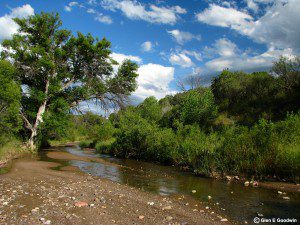
Jul 30, 2012 | Blog
Protecting Our Water Resources; Is Drought the New Normal?
 With the Summer Rain season in full swing, it’s easy to forget that we live in the desert. It’s also easy to forget that we are in a long-term drought. There have been two recent stories in the news about our strained water resources. Both stories discuss water flow in nearby Cienega Creek. KVOA offers NASA images capture Tucson – then and now. The Arizona Daily Star has an article called Cienega Creek, other S. AZ. streams, increasingly dry.
With the Summer Rain season in full swing, it’s easy to forget that we live in the desert. It’s also easy to forget that we are in a long-term drought. There have been two recent stories in the news about our strained water resources. Both stories discuss water flow in nearby Cienega Creek. KVOA offers NASA images capture Tucson – then and now. The Arizona Daily Star has an article called Cienega Creek, other S. AZ. streams, increasingly dry.
The drought raises questions. The biggest one is how in the world can we support mining in the Santa Rita and Patagonia Mountains given the huge amounts of water they consume? Rosemont’s supposed solution is using CAP water to recharge the aquifer. Whether it can be done and whether it will help is debatable. Regardless, Rosemont Copper can pump all the groundwater they want without the CAP recharge.
There are four other mining companies doing mineral explorations in the Patagonia Mountains. Arizona Mining Inc (Wildcat Silver), the one furthest along, estimated that their planned open pit mine would consume roughly 700,000 gallons of water per day. Per day! For comparison, the maximum pumping capacity of the Town of Patagonia’s well water is 110,000 gallons per day. Don’t forget the 3 other international mining companies that want to mine in the Patagonia Mountains. Using the figure of 700,000 gallons of water per day per mine results in 2.8 million gallons of water used per day. Big numbers need perspective.
Because all water sites seem to deal in acre feet, let’s do comparisons in those figures. 2.8 million gallons equals 8.6 acre feet. Estimated water usage from four mines per year using Arizona Mining Inc’s (Wildcat Silver) numbers comes out to 3,139 acre feet. The Santa Cruz Active Management Municipal Areas which includes Nogales, Rio Rico, Tubac, Arivaca, uses 7800 acre feet of water per year. That does not include Patagonia, Sonoita or Elgin. Mining in the Patagonia Mountains could potentially use almost half of all the water used annually in the most populated cities in Santa Cruz County.
Do we even have that much water? Is this drought the new normal?
Sources:
An Investigation of Energy Use, Water Supply and Wastewater Treatment at Patagonia, Arizona
AMA Cultural Water Demand – Municipal Demand
Trucks, water, and jobs at issue with silver mine
Jun 14, 2012 | Blog
Tombstone Arizona has made national headlines regarding its battle with the Forest Service over water rights. For 130 years pipelines have transported water from the Huachuaca Mountains 26 miles to Tombstone. The Monument Fire and subsequent mud slides last year destroyed this pipeline system. Tombstone has been trying to get emergency permission from the Sierra Vista District of the Coronado National Forest to bring in heavy equipment to repair the water system without success. The case has also gone to court, twice. Tombstone has lost both times.
Reasons given by the courts include the question of actual need and urgency of the repairs. Also in question is Tombstone’s entitlement to the water in the national forest. Tombstone claims rights to 25 springs while the Forest Service says they have permits for only 5. The federal government said none of that gives the city unfettered right of access. The Forest Service has also cited the Wilderness Protection Act as a reason for their reluctance to allow the requested repair of the pipeline. Machinery of any kind is banned in a Wilderness Area where the pipeline is located.
Another reason given was the presence of Mexican spotted owls. The owls are a threatened species. Supposedly, their presence is the big reason that the Forest Service wouldn’t grant Tombstone a permit to use heavy equipment to fix the pipeline. I have a hard time believing that one.
Here in the Patagonia Mountains we are lucky to still have Mexican spotted owls. Last year, the Sierra Vista District of the Coronado National Forest granted permission to Arizona Minerals aka Wildcat Silver to start exploratory drilling operations within Mexican spotted owl habitat. This drilling project would have operated 24 hours a day, 7 days a week, for 300 consecutive days. Along with noise and light disturbance there was the extremely high likelihood of destruction of owl habitat. Even the presence of a nearby federally-designated Mexican spotted owl Protected Activity Center didn’t block the approval of the drilling project. We, along with the Defenders of Wildlife and Sky Island Alliance had to sue the Forest Service to stop the drilling project.
It’s not just about the owls. The bigger question is how does the exact same Forest Service office come up with completely opposite policy actions?
U.S. high court denies Tombstone water relief
Sierra Vista Herald Sat, 06/02/2012
Tombstone readies picks and shovels
Sierra Vista Herald 06/07/2012
Spotted owl could be game-changer in Tombstone water war
CNN 06/09/2012
May 14, 2012 | Blog
One of those stories that caught our attention was the sudden and immediate departure of Arizona Mining Inc / Wildcat Silver (TSX:AZ) President and CEO Christopher M Jones, announced in a Arizona Mining Inc / Wildcat Silver press release dated May 7, 2012. Board members Richard Warke will assume CEO duties and Donald Taylor, will become President and Chief Operating Officer as well as continuing in their current duties.
You might remember Warke from other news. He is also on the Board of Directors for Augusta Resource (TSX/NYSE:AZC), the company that owns Rosemont Copper. He’s one of 2 men that Save the Scenic Santa Ritas called for investigations by U.S. and Canadian securities regulators, the Arizona Corporation Commission, and the Arizona Attorney General for failure to disclose past bankruptcy.
By the way, Augusta and Arizona Mining Inc / Wildcat Silver are closely related. In addition to Warke, they share 4 other Board members. They also list the same corporate office address, #400 – 837 Hastings St. Vancouver, BC.
It seems extremely odd that if all is going well, why the sudden departure of Chris Jones, President and CEO of Arizona Mining Inc / Wildcat Silver without a new replacement. Another interesting coincidence is that Augusta/Rosemont Copper also had a change at the top just two days later. Augusta announced the retirement of Raghunath Reddy as CFO in a press release dated May 9, 2012.
Two top level executives leaving the Augusta/Wildcat family within two days of each other seems peculiar to us. What about to you? We suppose that the reaction of the investors to this news will tell us more.











 With the Summer Rain season in full swing, it’s easy to forget that we live in the desert. It’s also easy to forget that we are in a long-term drought. There have been two recent stories in the news about our strained water resources. Both stories discuss water flow in nearby Cienega Creek. KVOA offers
With the Summer Rain season in full swing, it’s easy to forget that we live in the desert. It’s also easy to forget that we are in a long-term drought. There have been two recent stories in the news about our strained water resources. Both stories discuss water flow in nearby Cienega Creek. KVOA offers 